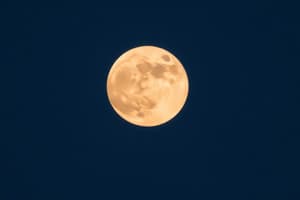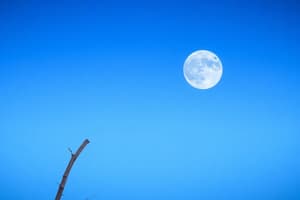Podcast
Questions and Answers
Considering the Moon's elliptical orbit, how does the distance at apogee compare to the average distance at perigee?
Considering the Moon's elliptical orbit, how does the distance at apogee compare to the average distance at perigee?
- The distance at apogee is approximately 27,000 miles farther than the average distance at perigee. (correct)
- The distance at apogee is approximately the same as the average distance at perigee.
- The distance at apogee is approximately 27,000 miles closer than the average distance at perigee.
- The distance at apogee is approximately 100,000 miles farther than the average distance at perigee.
If a full moon occurs when the Moon is 225,000 miles from Earth, how would its apparent size and brightness likely compare to an average full moon?
If a full moon occurs when the Moon is 225,000 miles from Earth, how would its apparent size and brightness likely compare to an average full moon?
- Roughly the same size and brightness as an average full moon.
- Significantly smaller and dimmer due to being near apogee.
- Much larger and brighter, regardless of the specific distance.
- Slightly larger and brighter, potentially classifiable as a supermoon. (correct)
Extrapolating from the provided data, what orbital condition must be met for a full moon to be considered a supermoon?
Extrapolating from the provided data, what orbital condition must be met for a full moon to be considered a supermoon?
- The full moon must occur when the Moon is at its apogee, exceeding 250,000 miles from Earth.
- The full moon must occur when the Moon is at or near its perigee, closer than average to Earth. (correct)
- The full moon must occur during a specific season, such as autumn or winter, irrespective of its distance from Earth.
- The full moon must occur within a few days of either the apogee or perigee.
Considering the information about the Beaver Moon and historical practices, how did environmental factors and human activities intersect during the North American fur trade era?
Considering the information about the Beaver Moon and historical practices, how did environmental factors and human activities intersect during the North American fur trade era?
If the timing of supermoons, like the upcoming November Beaver Moon, is predictable, what factors might cause the perceived viewing experience to differ from expectations?
If the timing of supermoons, like the upcoming November Beaver Moon, is predictable, what factors might cause the perceived viewing experience to differ from expectations?
If a hypothetical 'Harvest Moon' were to occur exactly one lunar cycle (approximately 29.5 days) after the Corn Moon in September 2024, on what date would it most likely be visible?
If a hypothetical 'Harvest Moon' were to occur exactly one lunar cycle (approximately 29.5 days) after the Corn Moon in September 2024, on what date would it most likely be visible?
Considering the pattern of full moon names and their association with seasonal activities or natural events, which of the following names would be most fitting for a full moon occurring in early January in a region experiencing heavy snowfall and the peak of wolf breeding season?
Considering the pattern of full moon names and their association with seasonal activities or natural events, which of the following names would be most fitting for a full moon occurring in early January in a region experiencing heavy snowfall and the peak of wolf breeding season?
A researcher aims to disprove the claim that supermoons cause earthquakes by analyzing seismic activity data during the full moons of 2024. Which approach would provide the strongest evidence against this claim?
A researcher aims to disprove the claim that supermoons cause earthquakes by analyzing seismic activity data during the full moons of 2024. Which approach would provide the strongest evidence against this claim?
Assuming the pattern from the provided table continues, which activity would be most closely associated with the full moon following December's Cold Moon?
Assuming the pattern from the provided table continues, which activity would be most closely associated with the full moon following December's Cold Moon?
Which of the following statements is the most accurate interpretation of the scientific perspective on the relationship between supermoons and Earth's geophysical events, based on the information provided?
Which of the following statements is the most accurate interpretation of the scientific perspective on the relationship between supermoons and Earth's geophysical events, based on the information provided?
Flashcards
Wolf Moon
Wolf Moon
Full moon in January
Snow Moon
Snow Moon
Full moon in February.
Worm Moon
Worm Moon
Full moon of March.
Pink Moon
Pink Moon
Signup and view all the flashcards
Flower Moon
Flower Moon
Signup and view all the flashcards
Supermoon
Supermoon
Signup and view all the flashcards
Lunar Perigee
Lunar Perigee
Signup and view all the flashcards
Lunar Apogee
Lunar Apogee
Signup and view all the flashcards
Beaver Moon
Beaver Moon
Signup and view all the flashcards
November 2024 Supermoon
November 2024 Supermoon
Signup and view all the flashcards
Study Notes
- The November full moon: also known as the Frost Moon, the Freezing Moon, and the Digging Moon.
- Some people think a supermoon's proximity to Earth can cause earthquakes or tidal waves.
- Scientists have found no evidence to support the claim that a super moon causes earthquakes.
- It is the last of four consecutive supermoons, following August's Blue Moon, September's Harvest Moon, and October's Hunter Moon
- The next supermoon will occur October 7, 2025.
- Supermoons appear 14% larger and 30% brighter than average full moons.
- Occurs when the full moon coincides with the lunar perigee (closest point to Earth in orbit).
- The distance for the 2024 supermoon is 224,853 miles (361,866 km) from Earth.
- The 2016 supermoon was the closest in recent history at 221,524 miles (356,508 km)
- The Moon's orbit is elliptical, so the distance between the Moon and Earth varies.
- The moon's furthest point is known as the apogee (253,000 miles (407,164 km) from Earth).
- At perigee (closest distance), the Moon is on average 226,000 miles (363,711 km) from Earth.
- The November full moon is referred to as the Beaver Moon.
- According to the Old Farmer's Almanac, this name refers to the time of year that beavers take shelter for the winter.
- During North America's fur trade era, it was also the season to trap animals for their thick, winter coats.
- The Old Farmer's Almanac has named every full moon
The 12 Full Moons of 2024
- Wolf Moon: January 25-26
- Snow Moon: February 23-24
- Worm Moon: March 24-25
- Pink Moon: April 23-24
- Flower Moon: May 22-23
- Strawberry Moon: June 21-22
- Buck Moon: July 20-21
- Sturgeon Moon: August 19-20
- Corn Moon: September 17-18
- Hunter's Moon: October 17
- Beaver Moon: November 15-16
- Cold Moon: December 14-15
Studying That Suits You
Use AI to generate personalized quizzes and flashcards to suit your learning preferences.





